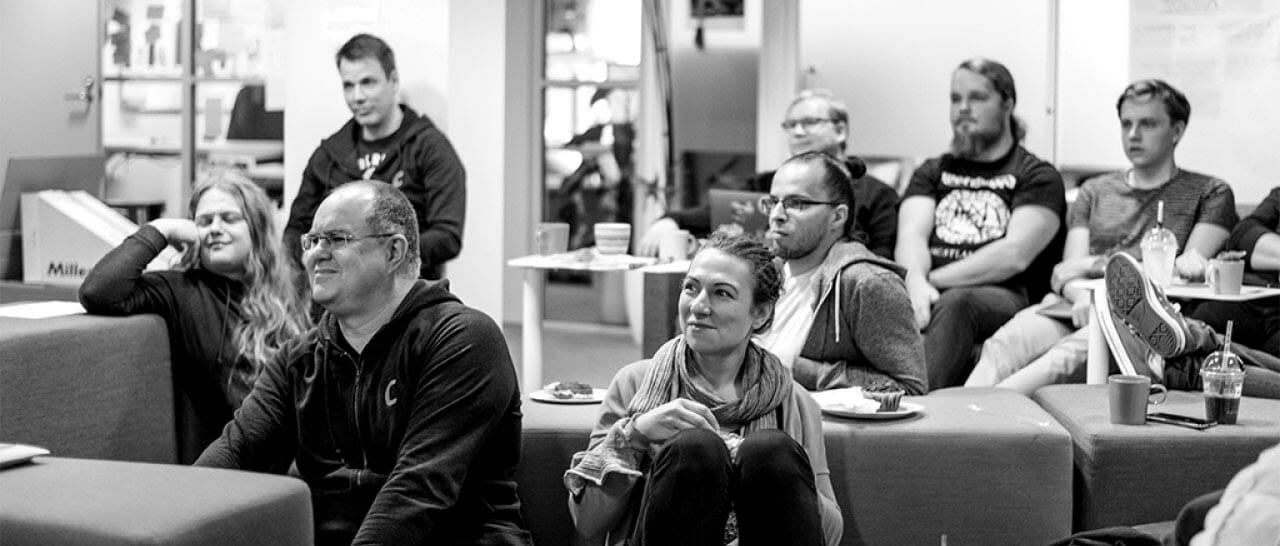By Maribel Alonso and Joserra Díaz
Company Info
Codento is a Finnish consultancy company based on sustainable software development where customer satisfaction is the most important, even if that means to recommend other companies to potential clients. They grow up together with customers helping those on achieving their goals and expectations.
Their values are: operating environment, continuous development, good feeling (build a better world creating a good feeling on a sustainable basis), always learning.
History
In 2016 they decided to try Sociocracy. They were 24 people but growing and needed structure. They didn’t want to replicate previous experiences with authority based decisions, so they looked for alternatives and found out about sociocracy (S3) which offered them a way to organize themselves without hierarchies based on management authority.
They have people specialized in technology development and people specialized in methodologies. So, as the first experiment, they decided to create two circles for the first group and one for the other. After 6 months they realized it was not working because people were more focused on the usual flow of work with customers than this change.
But they liked the first learnings about Sociocracy and decided to go “all-in” during the next 6 months. They hired external consultants for training and support. So they changed the whole organization into around 10 circles, with one circle by function where everyone was encouraged to participate in some of them. These 10 circles were: Growth circle (strategy and implementing it), Finance circle, HR circle, Sales circle, Marketing circle (merged at some point with Sales), Culture circle (S3 and other ways of working practices), Consultant circle (employee welfare and ways of working), Tech circle (technical consultant skill development and guidance), Methodology circle (agile coach consultant support) and Fun circle (recreation, sense of community)
And they were connected in a weekly general meeting (kind of general circle) with everybody in the company, where they discussed the topics that were relevant for the whole company. This weekly meeting is the highest operative decision body in the organization, even higher than the CEO.

After those months of experiments, some people left the company (maybe not only due to sociocracy changes but mainly), not everybody accepted or wanted the responsibility and the autonomy they suddenly got.
The experiment was evaluated and they decided to continue with Sociocracy. They found they improved in many ways: freedom to decide, better transparency and visibility, and even for recruiting was good as many people became interested in working with them.
During all this time, they have the full support of stakeholders and had to create the role of a board of directors due to law regulation. But the weekly meeting and some circles handled most of the typical board of directors responsibilities (f.ex. big decisions and strategy). This approach has been changing over the years.
Present
Currently, they are embedded in a new experiment to improve their structure and self-management. They decided to change from 10 circles into 3 customer-focused circles, each responsible for about a third of the company’s customers and check if this new organization improves their performance. So there are around 30 people organized in three circles by customer value (the objective is satisfying the demand -end-to-end- from customers) and three roles (CEO, Finances and HHRR) that are under exploration during three months.
All consultants are part of one circle according to the current customer project and change circles as needed. Also per circle, there is one salesperson and support from HR, finance and others as needed.
All circles have their backlog and are still connected in a weekly meeting where all employees can assist. What they try to preserve is important sociocracy values such as consent decision making, agenda, minutes, roles by nomination…
Working with consent decision making helps them in having all voices in meetings. They learned on making objections and being careful about making decisions in the responsibility defined for each circle, even the CEO understood he has one voice like others.
But one important thing is due to business they try to be flexible as they need to focus on customers so they communicate asynchronously often. However, they integrate symbols (consent, objection…) to keep the essence. As a funny note, they really have a better connection among all, even hugging each other, which in Finland seems to be not so common.
Related with that flexibility they also include other mindsets and practices like Agile, Lean….but with the company values and principles always in the first line and all employees believing in those. For supporting that they have a training on sociocracy practices because sociocracy improves how people relate to each other, improves empathy and makes relationships easier.
Conclusions
What can we learn from Codento´s experience with Sociocracy? In our opinion there are several key aspects:
- Initial experiment is important, the “buy-in” of the whole organization is important, but the support of the owners is mandatory. The governance model of a company must be aligned with shareholders’ expectations.
- Watch out to legal constraints: Depending on the country and the legal model, you will have different constraints for the organization.
- The benefits of autonomy and transparency are clear once shared in the company, boosting motivation and engagement. But not everybody is ready for them.
- A culture of experimentation is present and they continuously evolve and try new things to improve their self-management. It really fosters the values of transparency and adaptation.


Leave a Reply
You must be logged in to post a comment.